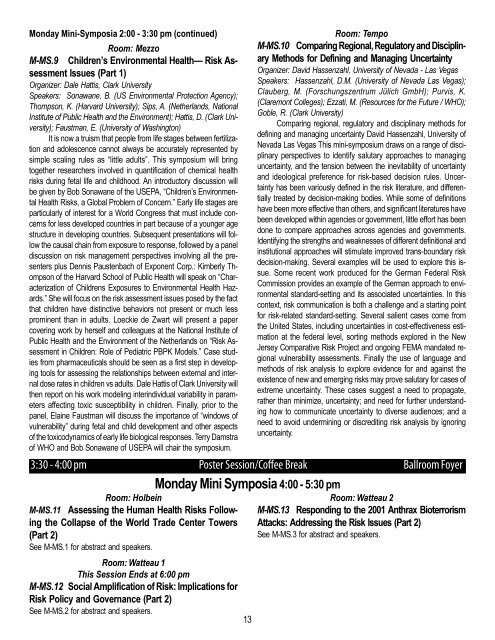Final Program World Congress on Risk - The Society for Risk Analysis
Final Program World Congress on Risk - The Society for Risk Analysis
Final Program World Congress on Risk - The Society for Risk Analysis
Create successful ePaper yourself
Turn your PDF publications into a flip-book with our unique Google optimized e-Paper software.
M<strong>on</strong>day Mini-Symposia 2:00 - 3:30 pm (c<strong>on</strong>tinued)<br />
Room: Mezzo<br />
M-MS.9 Children’s Envir<strong>on</strong>mental Health— <strong>Risk</strong> Assessment<br />
Issues (Part 1)<br />
Organizer: Dale Hattis, Clark University<br />
Speakers: S<strong>on</strong>awane, B. (US Envir<strong>on</strong>mental Protecti<strong>on</strong> Agency);<br />
Thomps<strong>on</strong>, K. (Harvard University); Sips, A. (Netherlands, Nati<strong>on</strong>al<br />
Institute of Public Health and the Envir<strong>on</strong>ment); Hattis, D. (Clark University);<br />
Faustman, E. (University of Washingt<strong>on</strong>)<br />
It is now a truism that people from life stages between fertilizati<strong>on</strong><br />
and adolescence cannot always be accurately represented by<br />
simple scaling rules as “little adults”. This symposium will bring<br />
together researchers involved in quantificati<strong>on</strong> of chemical health<br />
risks during fetal life and childhood. An introductory discussi<strong>on</strong> will<br />
be given by Bob S<strong>on</strong>awane of the USEPA, “Children’s Envir<strong>on</strong>mental<br />
Health <strong>Risk</strong>s, a Global Problem of C<strong>on</strong>cern.” Early life stages are<br />
particularly of interest <strong>for</strong> a <str<strong>on</strong>g>World</str<strong>on</strong>g> <str<strong>on</strong>g>C<strong>on</strong>gress</str<strong>on</strong>g> that must include c<strong>on</strong>cerns<br />
<strong>for</strong> less developed countries in part because of a younger age<br />
structure in developing countries. Subsequent presentati<strong>on</strong>s will follow<br />
the causal chain from exposure to resp<strong>on</strong>se, followed by a panel<br />
discussi<strong>on</strong> <strong>on</strong> risk management perspectives involving all the presenters<br />
plus Dennis Paustenbach of Exp<strong>on</strong>ent Corp.: Kimberly Thomps<strong>on</strong><br />
of the Harvard School of Public Health will speak <strong>on</strong> “Characterizati<strong>on</strong><br />
of Childrens Exposures to Envir<strong>on</strong>mental Health Hazards.”<br />
She will focus <strong>on</strong> the risk assessment issues posed by the fact<br />
that children have distinctive behaviors not present or much less<br />
prominent than in adults. Loeckie de Zwart will present a paper<br />
covering work by herself and colleagues at the Nati<strong>on</strong>al Institute of<br />
Public Health and the Envir<strong>on</strong>ment of the Netherlands <strong>on</strong> “<strong>Risk</strong> Assessment<br />
in Children: Role of Pediatric PBPK Models.” Case studies<br />
from pharmaceuticals should be seen as a first step in developing<br />
tools <strong>for</strong> assessing the relati<strong>on</strong>ships between external and internal<br />
dose rates in children vs adults. Dale Hattis of Clark University will<br />
then report <strong>on</strong> his work modeling interindividual variability in parameters<br />
affecting toxic susceptibility in children. <str<strong>on</strong>g>Final</str<strong>on</strong>g>ly, prior to the<br />
panel, Elaine Faustman will discuss the importance of “windows of<br />
vulnerability” during fetal and child development and other aspects<br />
of the toxicodynamics of early life biological resp<strong>on</strong>ses. Terry Damstra<br />
of WHO and Bob S<strong>on</strong>awane of USEPA will chair the symposium.<br />
Room: Tempo<br />
M-MS.10 Comparing Regi<strong>on</strong>al, Regulatory and Disciplinary<br />
Methods <strong>for</strong> Defining and Managing Uncertainty<br />
Organizer: David Hassenzahl, University of Nevada - Las Vegas<br />
Speakers: Hassenzahl, D.M. (University of Nevada Las Vegas);<br />
Clauberg, M. (Forschungszentrum Jülich GmbH); Purvis, K.<br />
(Clarem<strong>on</strong>t Colleges); Ezzati, M. (Resources <strong>for</strong> the Future / WHO);<br />
Goble, R. (Clark University)<br />
Comparing regi<strong>on</strong>al, regulatory and disciplinary methods <strong>for</strong><br />
defining and managing uncertainty David Hassenzahl, University of<br />
Nevada Las Vegas This mini-symposium draws <strong>on</strong> a range of disciplinary<br />
perspectives to identify salutary approaches to managing<br />
uncertainty, and the tensi<strong>on</strong> between the inevitability of uncertainty<br />
and ideological preference <strong>for</strong> risk-based decisi<strong>on</strong> rules. Uncertainty<br />
has been variously defined in the risk literature, and differentially<br />
treated by decisi<strong>on</strong>-making bodies. While some of definiti<strong>on</strong>s<br />
have been more effective than others, and significant literatures have<br />
been developed within agencies or government, little ef<strong>for</strong>t has been<br />
d<strong>on</strong>e to compare approaches across agencies and governments.<br />
Identifying the strengths and weaknesses of different definiti<strong>on</strong>al and<br />
instituti<strong>on</strong>al approaches will stimulate improved trans-boundary risk<br />
decisi<strong>on</strong>-making. Several examples will be used to explore this issue.<br />
Some recent work produced <strong>for</strong> the German Federal <strong>Risk</strong><br />
Commissi<strong>on</strong> provides an example of the German approach to envir<strong>on</strong>mental<br />
standard-setting and its associated uncertainties. In this<br />
c<strong>on</strong>text, risk communicati<strong>on</strong> is both a challenge and a starting point<br />
<strong>for</strong> risk-related standard-setting. Several salient cases come from<br />
the United States, including uncertainties in cost-effectiveness estimati<strong>on</strong><br />
at the federal level, sorting methods explored in the New<br />
Jersey Comparative <strong>Risk</strong> Project and <strong>on</strong>going FEMA mandated regi<strong>on</strong>al<br />
vulnerability assessments. <str<strong>on</strong>g>Final</str<strong>on</strong>g>ly the use of language and<br />
methods of risk analysis to explore evidence <strong>for</strong> and against the<br />
existence of new and emerging risks may prove salutary <strong>for</strong> cases of<br />
extreme uncertainty. <strong>The</strong>se cases suggest a need to propagate,<br />
rather than minimize, uncertainty; and need <strong>for</strong> further understanding<br />
how to communicate uncertainty to diverse audiences; and a<br />
need to avoid undermining or discrediting risk analysis by ignoring<br />
uncertainty.<br />
3:30 - 4:00 pm Poster Sessi<strong>on</strong>/Coffee Break Ballroom Foyer<br />
M<strong>on</strong>day Mini Symposia 4:00 - 5:30 pm<br />
Room: Holbein<br />
M-MS.11 Assessing the Human Health <strong>Risk</strong>s Following<br />
the Collapse of the <str<strong>on</strong>g>World</str<strong>on</strong>g> Trade Center Towers<br />
(Part 2)<br />
See M-MS.1 <strong>for</strong> abstract and speakers.<br />
Room: Watteau 1<br />
This Sessi<strong>on</strong> Ends at 6:00 pm<br />
M-MS.12 Social Amplificati<strong>on</strong> of <strong>Risk</strong>: Implicati<strong>on</strong>s <strong>for</strong><br />
<strong>Risk</strong> Policy and Governance (Part 2)<br />
See M-MS.2 <strong>for</strong> abstract and speakers.<br />
13<br />
Room: Watteau 2<br />
M-MS.13 Resp<strong>on</strong>ding to the 2001 Anthrax Bioterrorism<br />
Attacks: Addressing the <strong>Risk</strong> Issues (Part 2)<br />
See M-MS.3 <strong>for</strong> abstract and speakers.
















